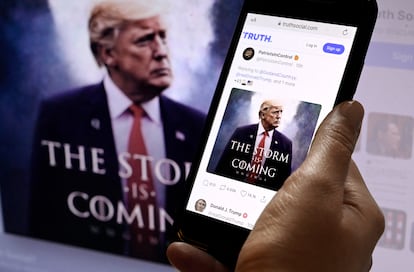Trump’s social media ‘bombs’ are a new source of instability for the financial markets
The possibility that the Republican could disrupt currencies or the stock markets with his unpredictable messages is forcing traders to pay close attention

Stockbrokers pay almost $30,000 a year per user for a subscription to a Bloomberg terminal, which provides them with real-time financial data. It’s a basic tool to help make investment decisions and react quickly whenever something happens in the world. In an ecosystem like that of the financial markets — where a seconds-long delay can make the difference between making or losing millions of dollars — the subscription is an expense that’s considered to be a basic necessity by some 350,000 clients around the world.
Now, that being said, there are two other instruments in the investor’s toolkit that shouldn’t be discarded since Donald Trump’s election victory: X (formerly Twitter) and Truth Social. On both social media accounts, the Republican pours out his comments at any time of the day or night. And his unpredictable, blunt statements are capable of immediately shifting currencies and stocks — even when he still hasn’t returned to the Oval Office.
This use of social media is unprecedented among previous presidents, creating turbulence for those who work in the financial sector. “It’s not a marginal issue. The tariff policy that he announces on social media directly affects inflation and, as a result, the yield curve and the currency,” says Ignacio de la Torre, chief economist at Arcano Economic Research. This means that — according to De la Torre — those who work “with bonds and interest rate derivatives” have to closely pay attention to what the president-elect posts online.
One does not have to go too far back to find messages that bring together these issues. For instance, this past Sunday, Trump published a message on X, where he deployed his particular way of negotiating — full of threats and grammatical errors — regarding a currency issue with the potential to impact international markets and trade.
“The idea that the BRICS Countries are trying to move away from the Dollar while we stand by and watch is OVER,” he posted. “We require a commitment from these Countries that they will neither create a new BRICS Currency, nor back any other Currency to replace the mighty U.S. Dollar or, they will face 100% Tariffs, and should expect to say goodbye to selling into the wonderful U.S. Economy. They can go find another ‘sucker!’ There is no chance that the BRICS will replace the U.S. Dollar in International Trade, and any Country that tries should wave goodbye to America.”
The idea that the BRICS Countries are trying to move away from the Dollar while we stand by and watch is OVER. We require a commitment from these Countries that they will neither create a new BRICS Currency, nor back any other Currency to replace the mighty U.S. Dollar or, they…
— Donald J. Trump (@realDonaldTrump) November 30, 2024
Trump’s frequent use of social media to make such warnings has partially immunized public opinion. But still, market reactions continue. On Monday, the dollar index — which measures the evolution of the U.S. dollars against a basket of currencies — rose by half-a-point. More pronounced was the response to the messages Trump published on November 25 on Truth Social — the social media platform he owns — where his activity is more consistent than on his friend Elon Musk’s network. “On January 20, as one of my first Executive Orders, I will sign all necessary documents to charge Mexico and Canada a 25% tariff on ALL products entering the United States. This tariff will remain in effect until drugs, particularly fentanyl, and all illegal aliens stop this invasion of our country!” He then threatened to impose an additional 10% tariff on China if they failed to stop fentanyl trafficking into the United States.
Following the publication, the currencies of Mexico and Canada fell by more than 1% — a high percentage for a single session. The Chinese yuan also lost ground. This isn’t a new way of behaving: Trump already used this style in his first term, increasing volatility and forcing traders to pay close attention. “We used to call them Twitter bombs,” Matthew Haupt — a portfolio manager at Wilson Asset in Sydney, Australia — told Bloomberg.
“I ignore the news, including Trump”
Jordi Martí — an independent, professional trader — says that he doesn’t need to monitor what Trump says. He only acts when the president-elect upsets the charts. “As a trader, I totally ignore the news, including Trump. Everything that happens in the market is reflected in price movements, and I see that in the charts. It’s true that Trump’s tweets can move the market at times, as can those of Musk and others, but this translates into very specific price movements on the charts. It’s much easier to control a single variable [price] than all the things that the media impacts.”
That’s not to say Trump’s outbursts don’t influence his trading. “Distortions can be spotted quickly via unexpected and illogical volume increases… long before the reason is reported in the media. Certainly, I can change a trading direction — but based on what the chart tells me, not the news,” he clarifies. According to trading platform IG, the volatility index (VIX) — also known as the “fear index” — spiked after certain Trump tweets in his first presidency. This created opportunities for less risk-averse traders, who seek extreme volatility.
A study published in 2021 by four researchers from universities in Norway, the Czech Republic and Poland found that Trump’s tweets “are followed by increased uncertainty, increased trading and a decline in the U.S. stock market.” The response was particularly negative after tweets containing the words “products,” “tariff” and “trade war.”
One of the most difficult weeks took place in May 2019, when Trump’s tweets threatening China caused the stock market to lose $1.7 trillion in market capitalization. The effect — according to the researchers’ analysis — wasn’t only felt on Wall Street. Chinese stocks often responded negatively to these messages, while the price of gold — a traditional safe haven asset — often responded positively.
Sign up for our weekly newsletter to get more English-language news coverage from EL PAÍS USA Edition
Tu suscripción se está usando en otro dispositivo
¿Quieres añadir otro usuario a tu suscripción?
Si continúas leyendo en este dispositivo, no se podrá leer en el otro.
FlechaTu suscripción se está usando en otro dispositivo y solo puedes acceder a EL PAÍS desde un dispositivo a la vez.
Si quieres compartir tu cuenta, cambia tu suscripción a la modalidad Premium, así podrás añadir otro usuario. Cada uno accederá con su propia cuenta de email, lo que os permitirá personalizar vuestra experiencia en EL PAÍS.
¿Tienes una suscripción de empresa? Accede aquí para contratar más cuentas.
En el caso de no saber quién está usando tu cuenta, te recomendamos cambiar tu contraseña aquí.
Si decides continuar compartiendo tu cuenta, este mensaje se mostrará en tu dispositivo y en el de la otra persona que está usando tu cuenta de forma indefinida, afectando a tu experiencia de lectura. Puedes consultar aquí los términos y condiciones de la suscripción digital.
More information
Archived In
Últimas noticias
ChatGPT fails the test: this is how it endangers the lives of minors
The late consecration of women artists in their 90s
The Florida Keys tourist paradise is besieged by immigration agents: ‘We’ve never seen anything like this’
The latest scam on WhatsApp behind the legal dream: using immigration status as bait
Most viewed
- Families demand repatriation of bodies of Colombians who died in Ukraine: ‘This war is a slaughterhouse for foreigners’
- The low-cost creative revolution: How technology is making art accessible to everyone
- Liset Menéndez de la Prida, neuroscientist: ‘It’s not normal to constantly seek pleasure; it’s important to be bored, to be calm’
- Christian Louboutin: ‘Young people don’t want to be like their parents. And if their parents wear sneakers, they’re going to look for something else’
- ‘El Limones’ and the growing union disguise of Mexican organized crime










































